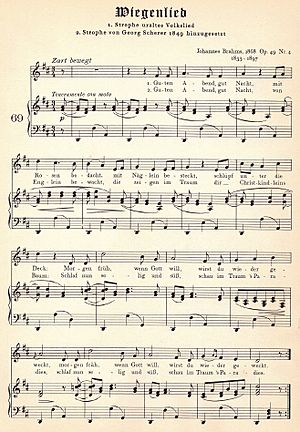Wiegenlied (Brahms) facts for kids
"Wiegenlied" (which means "Lullaby" or "Cradle Song" in German) is a very famous song written by Johannes Brahms. It's also known as Op. 49, No. 4. Brahms first shared this song in 1868. It quickly became one of his most popular pieces of music.
Contents
About the Song
This song might sound simple, but it's actually quite clever. When it was first published, it only had one part of the lyrics.
Song Lyrics
The words for the song come from an old German collection of folk poems called Des Knaben Wunderhorn. Here are the original words and what they mean:
|
Guten Abend, gut' Nacht, |
Good evening, good night, |
| —First edition (1868) | —Translation |
Later on, Brahms added a second part to the song. He used words from a poem written by a person named Georg Scherer in 1849:
|
Guten Abend, gut' Nacht, |
Good evening, good night. |
| —Georg Scherer (1849) | —Translation |
The Melody
Here's what the music for the lullaby looks like: <score %vorbis="1"%%T257066%> \relative g' {\set Staff.midiInstrument = #"flute" \key es \major \time 3/4 \autoBeamOff \partial 4 g8 g | bes4. g8 g4 | bes r g8[_( bes)] | es4 d4. c8 | c4( bes) f8[_( g)] |aes4 f f8[_( g)] | aes4 r f8[_( aes)] | d[_( c)] bes4 d | es r es,8 es | es'2 c8 aes | bes2 g8 es | aes4 bes c | \appoggiatura g8 bes2 es,8 es | es'2 c8 aes | bes2 g8 es | \afterGrace aes4( { bes16[ aes]) } g4 f | es2 \bar "|." } \addlyrics { Gu -- ten A -- bend, gut' Nacht, mit Ro -- sen be -- dacht, mit Näg -- lein be -- steckt, schlupf un -- ter die Deck': Mor -- gen früh, wenn Gott will, wirst du wie -- der ge -- weckt, mor -- gen früh, wenn Gott will, wirst du wie -- der ge -- weckt. } </score>
Did you know that Brahms used the tune from this lullaby in another one of his big pieces? In 1877, he used it as a main part of the first movement of his Second Symphony. The melody first appears about halfway through that part of the symphony and keeps showing up.
Different Versions
Many musicians have made their own versions of "Wiegenlied." This is called an arrangement.
In 1922, a pianist and composer from Australia named Percy Grainger made his own special arrangement of the lullaby for solo piano. He called it one of his "Free Settings of Favorite Melodies." In his version, Grainger used lots of musical techniques like suspensions (where a note is held on before resolving) and arpeggios (playing notes of a chord one after another). He also liked to put the main tune in the middle range of the piano keys, which was a favorite trick of his.
Recordings
Many famous singers and musicians have recorded Brahms's Lullaby. Here are a few examples:
- In 1958, Joni James recorded it for her album Among My Souvenirs.
- In 1962, Elisabeth Schwarzkopf (a soprano singer) and Gerald Moore recorded it.
- In 1989, Anne Sofie von Otter (a mezzo-soprano singer) and Bengt Forsberg (piano) recorded it.
- In 1994, Kenny G recorded an instrumental version called "Brahms Lullaby" for his album Miracles: The Holiday Album.
- In 2013, Bernarda Fink (a mezzo-soprano) and Roger Vignoles (piano) recorded it.
Images for kids
[[scores:{{{id}}}|J. Brahms: 5 Songs, Op. 49]]: Free scores at the International Music Score Library Project
See also
 In Spanish: Canción de cuna (Brahms) para niños
In Spanish: Canción de cuna (Brahms) para niños



